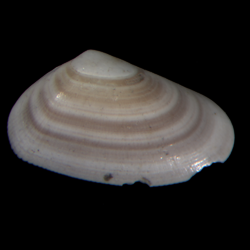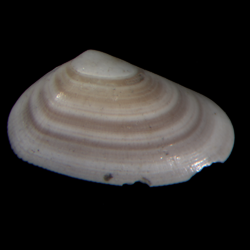
Donacidae

- Phylum: Mollusca
- Class: Bivalvia
- Order: Imparidentia
- Family: Donacidae
Overview
Common name: Wedge clams, bean clams, and coquinas
Key morphological features: The Donacidae are small to medium sized, up to 150 mm. The shells are equivalve and solid, with an elongated or wedge shape. The anterior end is narrow and rounded, while the posterior end is oblique, truncated and may have a radial keel or sulcus. The shell is composed of aragonite and exterior sculpture is smooth to radial, with more sculpturing around the dorsal posterior end. Valve interiors are non-nacreous. The pallial line is unbroken and has a distinct sinus, and the interior shell margins are smooth or denticulate. Species of Donacidae are isomyarian, with both adductor muscles equal in size. The heterodont hinge is strong, and each valve contains two cardinal teeth. Source: Mikkelsen, P.M., and Bieler, R. 2008. Seashells of Southern Florida: Bivalves. Princeton, New Jersey: Princeton University Press. 503 pp.
Geological range: Cretaceous to Recent (Mikkelsen & Bieler, 2008).
Geographic distribution: A distributional map for modern Donacidae may be accessed from OBIS. A distributional map for ancient Donacidae may be accessed from the Paleobiology Database.
Diversity: There are 102 recognized living species of Donacidae and 5 genera (WoRMS database, unvetted). The Paleobiology Database recognizes 7 fossil genera and 34 fossil species of Donacidae (unvetted).
Paleoecology: The Donacidae are marine suspension feeders that often occur together in extreme quantities. They are capable of rapidly reburying themselves if exposed by wave surges. Donacids are commonly harvested for food or bait. They are found commonly on beaches worldwide, and some live in estuarine or fresh waters. Source: Mikkelsen and Bieler (2008).
Phylogenetic status: Unknown. Recent molecular phylogenetic analysis by Fernández-Pérez et al. (2017) supports the monophyly of genus Donax, but further studies on other members of the Donacidae are lacking.
